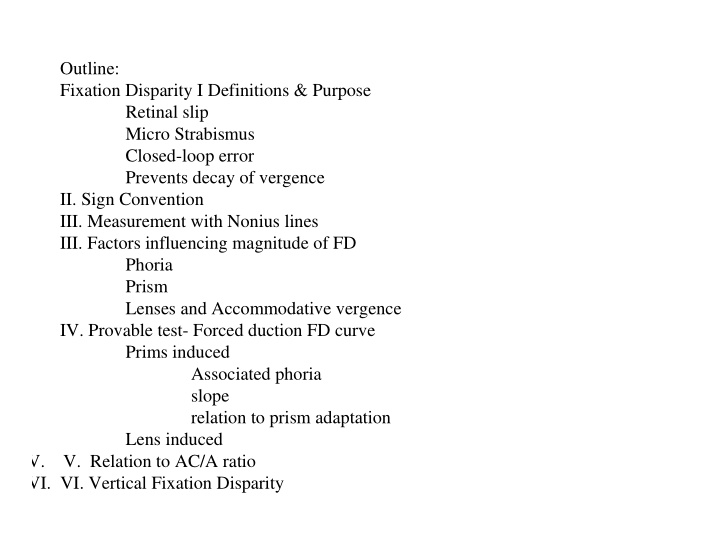



Outline: Fixation Disparity I Definitions & Purpose Retinal slip Micro Strabismus Closed-loop error Prevents decay of vergence II. Sign Convention III. Measurement with Nonius lines III. Factors influencing magnitude of FD Phoria Prism Lenses and Accommodative vergence IV. Provable test- Forced duction FD curve Prims induced Associated phoria slope relation to prism adaptation Lens induced V. V. Relation to AC/A ratio VI. VI. Vertical Fixation Disparity
Four Maddox Components of Convergence Tonic Proximal Fusional Accommodative
Fusional vergence component is a buffer that takes up the slack left by the other four components. The “slack” or residual error of the sum of tonic, proximal and accommodative vergence is measured as the phoria. Stress is assumed to be related to the amount of fusional vergence effort under binocular viewing conditions. Prism adaptation reduces the demand on fusional vergence by increasing tonic vergence under binocular viewing conditions.
Shortfall of the Maddox classification in the classical case analysis: The Maddox classification assumes that the phoria, measured under monocular conditions, equals the residual error under binocular viewing conditions. Maddox does not consider prism adaptation , that reduces the demand on fusional vergence under binocular viewing conditions.
Instead of assuming the dissociated phoria equals the demand on fusional vergence under binocular viewing conditions, why not measure the stress on fusional vergence directly under binocular viewing conditions? How can we assess the demand under binocular viewing conditions? Fixation disparity is a small error under binocular viewing conditions that is proportional to the demands on fusional vergence.
Fixation Disparity is a steady-state error - Room temperature thermostat analogy. Under binocular viewing conditions, it keeps the eyes from drifting back to their position of rest. Fixation disparity increases when we fuse with the phasic component of disparity vergence . It is analogous to trying to heat a room with open windows. Fixation disparity decreases when we fuse with adaptable tonic vergence . This is analogous to heating a room with sealed windows.
Fixation Disparity - Definition • Fixation disparity is the difference between the convergence angle under binocular viewing and the angle subtended by the target at the centers of rotation Convergence Point Fixation Plane Fixation Plane Fixation Disparity ESO Fixation Disparity EXO Fixation Disparity
Fixation disparity: A small error in convergence or eye alignment in the presence of feedback from disparity. Phoria A vergence error without fusion (i.e. when one eye is occluded- i.e. open-loop or without feedback from disparity). AKA dissociated phoria Synonyms- Retinal slip Micro- strabismus
Sign Convention: Eso (+) excessive convergence error Exo (-) excessive divergence error Units of measurement: Minutes of arc. Measurement tools using Nonius lines: Nonius lines are a measure of Dichoptic Vernier Acuity Mallett Unit - Measures the amount of prism needed to reduce fixation disparity to zero ( associated phoria ) Disparometer - Measures the fixation disparity directly. Demonstrations:
Nonius lines are adjusted to lie on each fovea and their offset indicates the small vergence error, i.e. Fixation Disparity
Factors that influence the magnitude of FD. 1) Phoria Eso FD increases with Eso phoria Exo FD doesn’t increase with Exo phoria 1) Prisms (Base-out ∆ reduces Eso and increases Exo) (Base-in ∆ reduces Exo and increases Eso) 2) Lenses (Plus lenses reduce Eso and increases Exo) (Minus lenses reduce Exo and increase Eso) Forced Duction (prism induced) Fixation Disparity Curve: A provocative tests of prism adaptation. Measure changes in fixation disparity with added prisms. .
Phoria Status and Fixation Disparity Three things are of interest to us… 1. The Y-intercept (Habitual FD) 2. The X-intercept (Associated Phoria) 3. The slope ( ∆ ∆ ∆ ∆ y / ∆ ∆ ∆ ∆ x)
Associated phoria - the amount of prism that reduces fixation disparity to zero- good index of how much prism to prescribe. Dissociated phoria - the amount of prism that reduces the phoria to zero under open-loop conditions. Standard clinical phoria measure.
Four categories of forced duction Fixation Disparity Curves 20% Adapts well to base-out prism Adapts Most common 75% equally to Base in and out prism 5% Adapts well to Rare anomalous Base In prism response found in strabismus
Lens induced FD Prism induced FD Estimate the AC/A under binocular conditions. Plot lenses against prisms that produce the same fixation disparity
Vertical Fixation Disparity induced with vertical prism
Could there be Cyclo vergence fixation disparity? Yes, but its not measured clinically.
Measuring Fixation Disparity Nonius lines • Measured using Nonius lines • View of right and left eyes’ separated using red-green goggles or polaroid goggles • Patient makes qualitative judgment about whether the upper line is to the right or to the left of the lower line • The perceived location of the upper line is opposite to the deviation of the eye
Measuring Fixation Disparity Demonstrate fixation disparometer Demonstrate fixation disparity software Mallett Unit
Prism induced fixation disparity curve
Recommend
More recommend